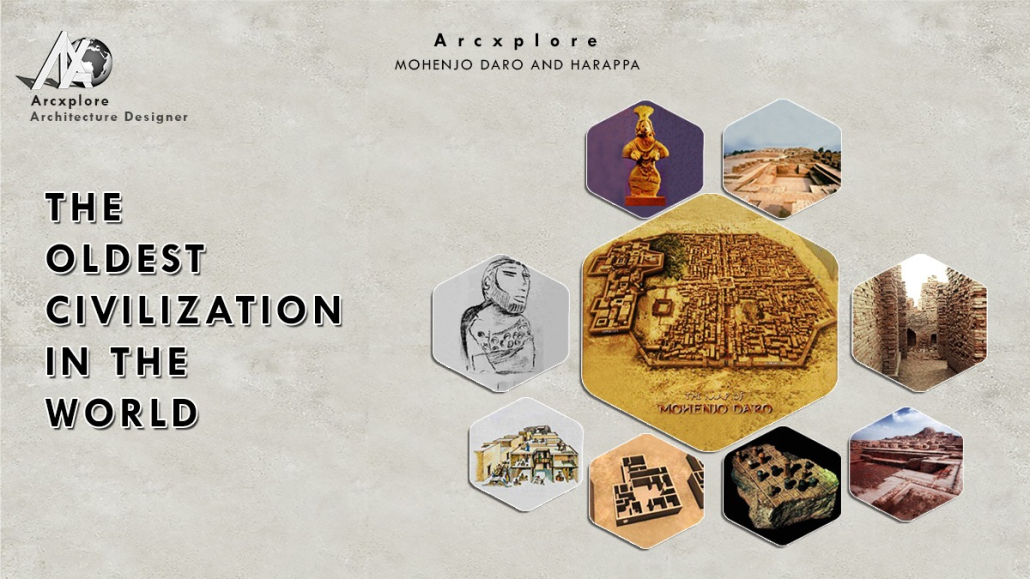Oldest World Civilization Mohenjo Daro and Harappa
Introduction
The Oldest Civilization in the World Indus Valley – Mohenjo Daro and Harappa for decades, academia has claimed to know the ages of our planet’s oldest known civilizations, providing us with precise timelines that essentially make up what we know as our historical paradigm.
At the same time, independent researchers and scholars have repeatedly questioned and challenged these timelines, claiming that they are inconsistent and, in many cases, flat-out wrong. Perhaps no better example of this inaccuracy than the age of the Indus Valley Civilization.
Indus Valley Rediscovery
Charles Masson
Oldest World Civilization
The first modern accounts of the ruins of the Indus civilization are those of Charles Mason in 1829 Mason traveled through Punjab gathering useful intelligence for the East India Company Mason’s major archaeological discovery in Punjab was Harappa a metropolis of the Indus civilization
Masson took detailed notes and sketches of her Appa’s extensive historical relics, which were buried in the Ravi River’s disease-ridden valley.
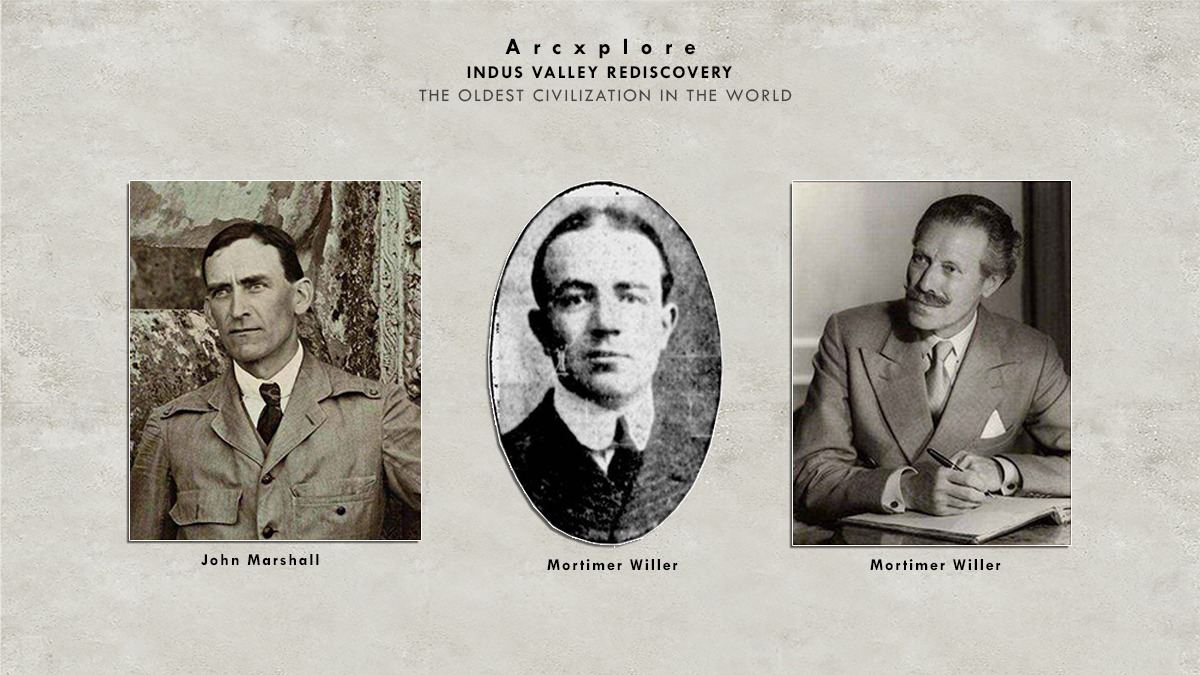
Many seemed partially buried in plain sight after the British invasion of Punjab in 1848 and 49, a considerable number of its bricks were carried away as track ballast for the company’s 100-mile rail route.
Although archaeology on the subcontinent became more formally organized with the founding of the Archaeological Survey of India in 1861, archaeological work and Harappa remained stagnant until 1904, when the Ancient Monuments Preservation Act was passed and John Marshall was appointed to lead the ASI.
John Marshall
Marshall subsequently directed ASI archaeologist de Aram Sami to excavate the sites into mounds between 1921 and 1922. Meanwhile, farther south along the Indus’ main stem, the fairly untouched site of Mohenjo-Daro had piqued Marshall’s interest, and between 1911 and 1924, a series of ASI officials were assigned to investigate the site, and systematic excavations began in Mohenjo-Daro.
With K induction during 1924 and 1925, Hargreaves between 1925 and 26, and Ernest J Mackay between 1927 and 1931, most of Mohenjo-Daro had been excavated by 1931. After India’s partition in 1947, many more had been excavated.
Mortimer Willer
Oldest World Civilization
From 1944 to 1947, Mortimer Willer, the director of ASI, led the formation of archaeological organizations in Pakistan before joining a UNESCO initiative to preserve the Mohenjo-Daro monument.
Partition
In contrast to India, where the ASI attempted to Indian eyes archaeological work in keeping with the new nation’s goals of national unity and historical continuity after 1947, in Pakistan, the national imperative was the promotion of Islamic heritage, and thus archaeological work on earlier sites was left to foreign archaeologists after the partition.
The Harrapan Civilization
Oldest World Civilization
Scholars believe Indian culture originated approximately 1250 BCE in the Ganges Valley when Aryan immigrants from Persia and Central Asia dominated the area. The discovery of ancient Harappan towns in the 1920s, however, shattered that notion and pushed the date back.
For over a century, academics asserted with seeming certainty that the Indus Valley Civilization was roughly 5,500 years old, going back another 2,000 years.
They divided it into three phases: the early Harappan phase from 3300 to 2600 BCE, the mature Harappan phase from 2600 to 2800 BCE, and the late Harappan phase from 2600 to 2800 BCE.
Harappan phase from 2600 to 1900 BCE
And the late Harappan phase from 1900 to 1300 BCE all of that changed in 2016 when evidence was uncovered by the Indian Institute of technology and the archaeological survey of India that the civilization was actually at least 8,000 years old the findings come from a major excavated site at barani. From pre-Harappan khakhra through early mature Harappan to mature Harappan eras, Haryana displays the preservation of all cultural phases of this ancient civilization.
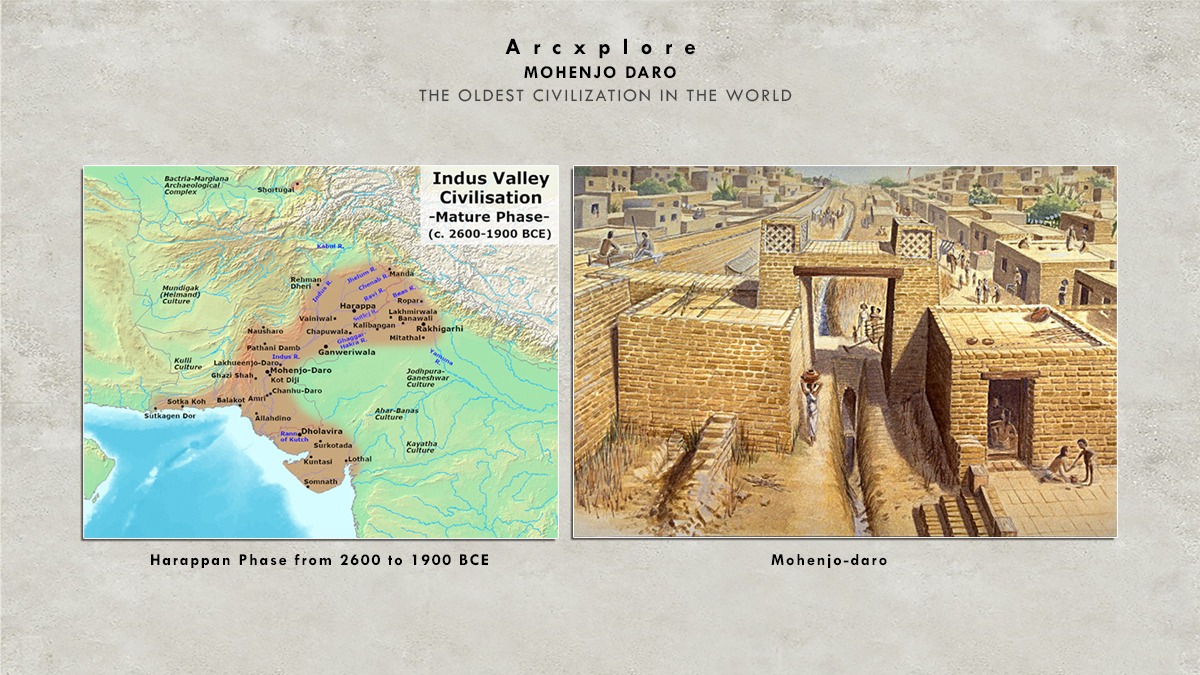
While earlier periods were characterized by pastoral and early village agricultural groupings, mature Harappan settlements were highly urbanized, with numerous structured cities, sophisticated material and artisan culture, and Trans.
The late Harappan age saw wide-scale urbanization population drop abandonment of many existing towns lack of basic amenities interpersonal violence and loss of the Harappan script, which was traded between two locations as far apart as Arabia and Mesopotamia.
Burano was part of a densely populated area along with the now-dry Vedic River Valley Saraswati, where the researchers discovered some of the civilization’s oldest pottery.
They used an optically stimulated luminescence technique to date early mature rap pottery shards to nearly 6,000 years ago and pre-Harappan chakra cultural levels to as far back as 8,000 years. The excavation also yielded large quantities of animal remains such as bones teeth horn cores of cows goats deer and antelope.
The researchers looked at the oxygen isotope composition in the bones’ bone and dental phosphates to decipher the climate pattern, which was based on a carbon-14 study, to better comprehend antiquity as well as the environmental circumstances in which civilization developed.
Scientific Reports
The oxygen isotope in animal bones and teeth maintained the characteristics of ancient meteoric water, and consequently the intensity of monsoon rains.
According to the findings, pre-Harappan humans first settled in this area around the gagger and Hakra Rivers, where the environment was conducive to human settlement and agriculture.
Many archaeologists have long believed that the monsoon was considerably stronger between 9,000 and 7,000 years ago and that it nourished these rivers, enhancing their strength with extensive flood plains.
Many archaeologists think that the Burana, as well as many other Indus Valley sites in India, are far older than 5,700 years.
According to professor Sarkar of the Indian Institute of Technology’s department of geology and geophysics, “our discovery pushes back the antiquity to as early as the 8th millennium before present and will have substantial ramifications for the evolution of human settlements in the Indian subcontinent.” On May 25th, 2016, the findings were published in the journal Nature scientific report.
Indus Valley Decline
Experts have previously stated that the Indus River dried up as a result of climate change, but there are numerous alternative possibilities – including. The invasion of the Aryans resulted in catastrophic floods, societal strife, and the spread of contagious illnesses.
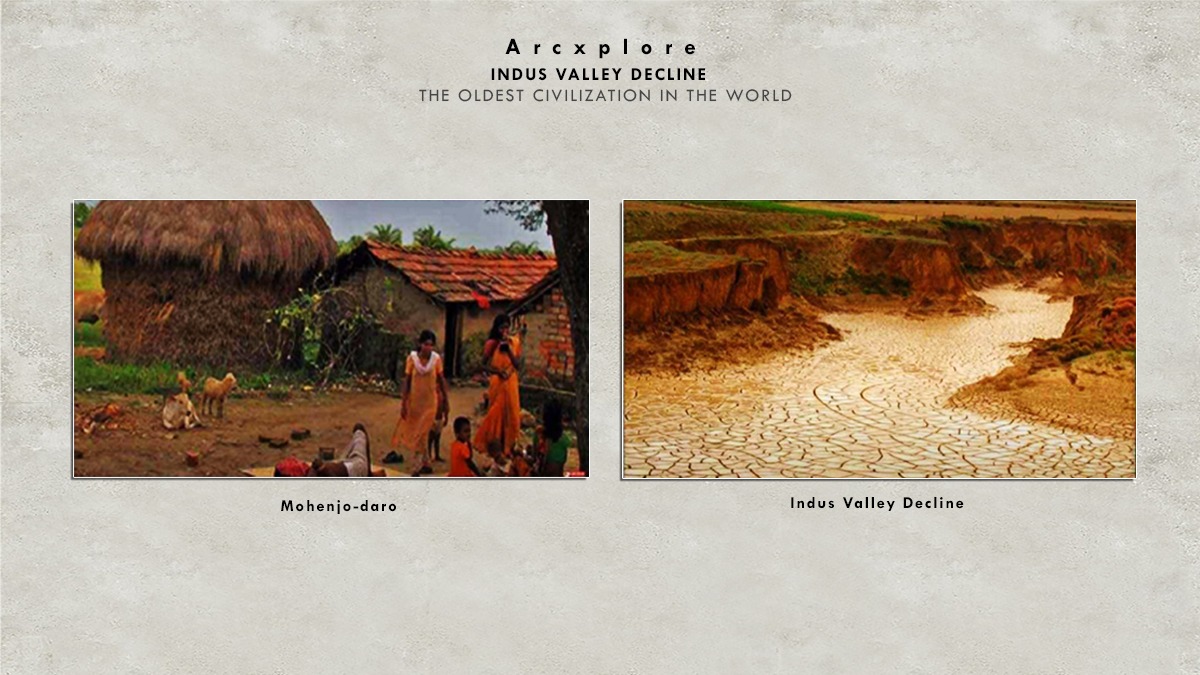
The team, on the other hand, has suggested a new theory, arguing that the environment was unlikely to be the reason for her untimely death. They suggested that, between 9,000 and 7,000 years ago, ancient peoples relied on huge and frequent monsoons to water their fields, but evidence from Verona shows that people survived despite altering weather patterns beyond that period.
Growing evidence implies that these people’s agricultural patterns changed away from large grain cereals like wheat and barley.
They moved to drought-resistant tiny millets in the early part of the enhanced monsoon and rice in the latter portion of the falling monsoon, modifying their substance approach in the process. However, changing the crops they grew and harvested resulted in the deep urbanization of cities and the elimination of the need for large food storage facilities.
The people swap to personal storage spaces to look after their families because these later crops generally have much lower yields than the organized large storage system of the Mature. The Harappan period was abandoned giving rise to smaller more individual household-based crop processing and storage systems and possibly acted as a catalyst for the deep urbanization of the Harappan civilization rather than an abrupt Collapse
The Importance of the Indus Valley Civilization
Oldest World Civilization
Harappa and Mohenjo-Daro were two of the seven rishi cities of the Rama Empire, according to ancient Epic’s esoteric doctrine. The importance of the Indus Valley Civilization cannot be overstated, especially when other civilizations were devoting vast amounts of time and resources to the rich, supernatural, and dead.
Sure, they believed in an afterlife and used a system of social divisions, but they also believed that resources were more valuable in circulation among the living than on display or buried underground. Let’s look at some of the more intriguing characteristics of this civilization.
The Indus script is the most mysterious of all deciphered scripts in the world, consisting of partially pictographic signs and various human and animal motifs, including a perplexing unicorn, that have been found inscribed on miniatures, steatite seals, terracotta tablets, and occasionally on metal linguistic.
For decades, experts and scientists have been attempting to interpret this difficult script, which may hold the key to unlocking the mysteries of this fascinating civilization. In the race to be the world’s first script, Mesopotamia’s cuneiform system is up against some stiff competition.
Town Planning
Residents of the ancient Indus civilization towns were adept urban planners who prioritized water well management, as indicated by a well-planned street grid and complex drainage system.
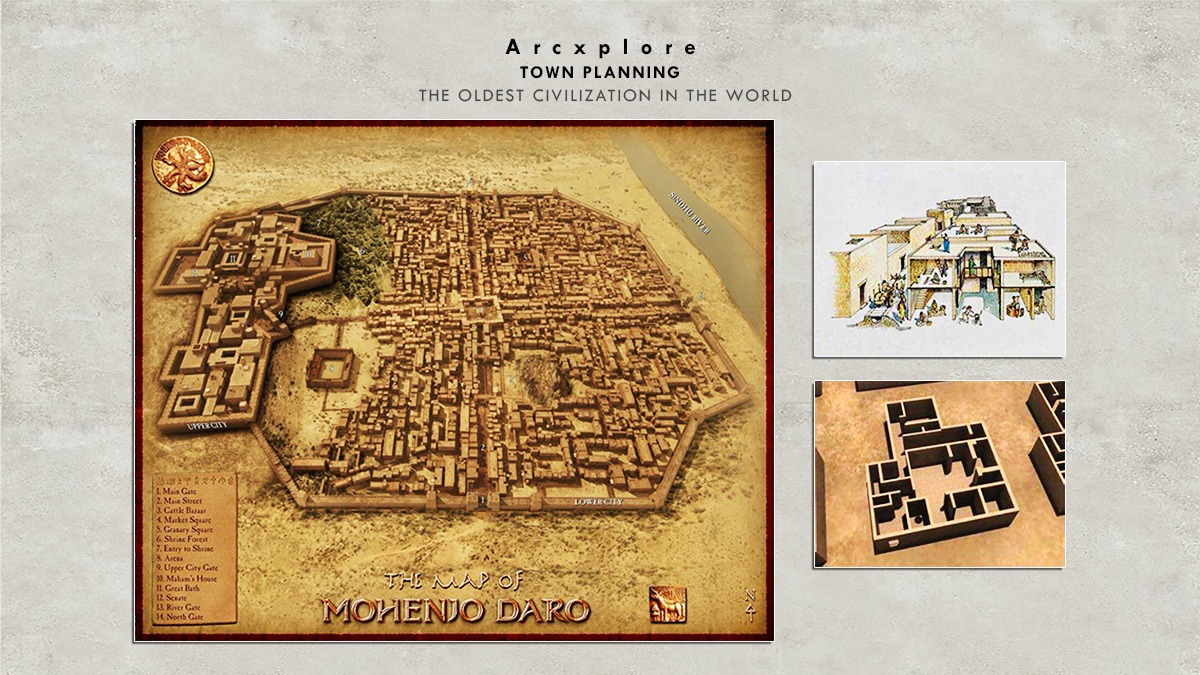
Almost every home has a designated bathing area as well as a covered drainage system.
Urban Life
The affluence and stature of the city may be shown in items such as beads, jewelry, and ceramics recovered from practically every house, as well as the baked brick city structures themselves.
The city’s absence of extravagant buildings like palaces and temples, as well as no evident central seat of authority or indication of a ruler, as well as the lack of any weaponry, indicated that the Indus people had few adversaries and preferred to live in peace the most commonly found artifact
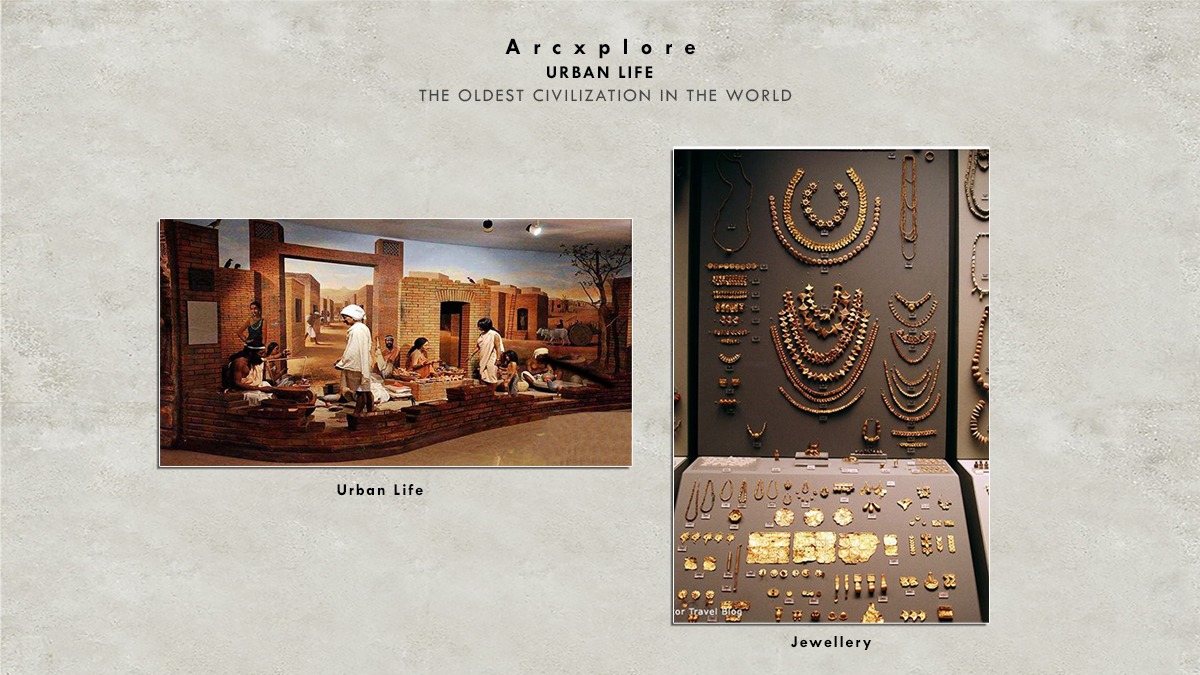
Both men and women decorate themselves with a wide array of ornaments made from every imaginable material, ranging from precious metals and diamonds to bone and baked clay, in the Indus Valley Civilization. Cotton was most likely dyed in a range of hues, according to dying facilities discovered. They were also aware of the usage of cinnabar vermilion and kaliram as cosmetics.
Trade without Money
The sills and weights discovered in the ruins of many Harappan cities imply that the Indus culture relied heavily on a system of strictly controlled trade based on barter rather than money and that its chief trading partner was the vanished uppity Mia.
There is evidence that people in Mesopotamian towns enjoy Harappan luxury items including beads, ceramics, swords, and tiny carved bones.
World’s Earliest Known Dockyard
Oldest World Civilization
During the demise of the Indus Valley Civilization, the world’s first known dockyard was discovered. The dock connected the city to an old stream of the Shaba strong river, measuring 37 meters east to west and 22 meters north to south.
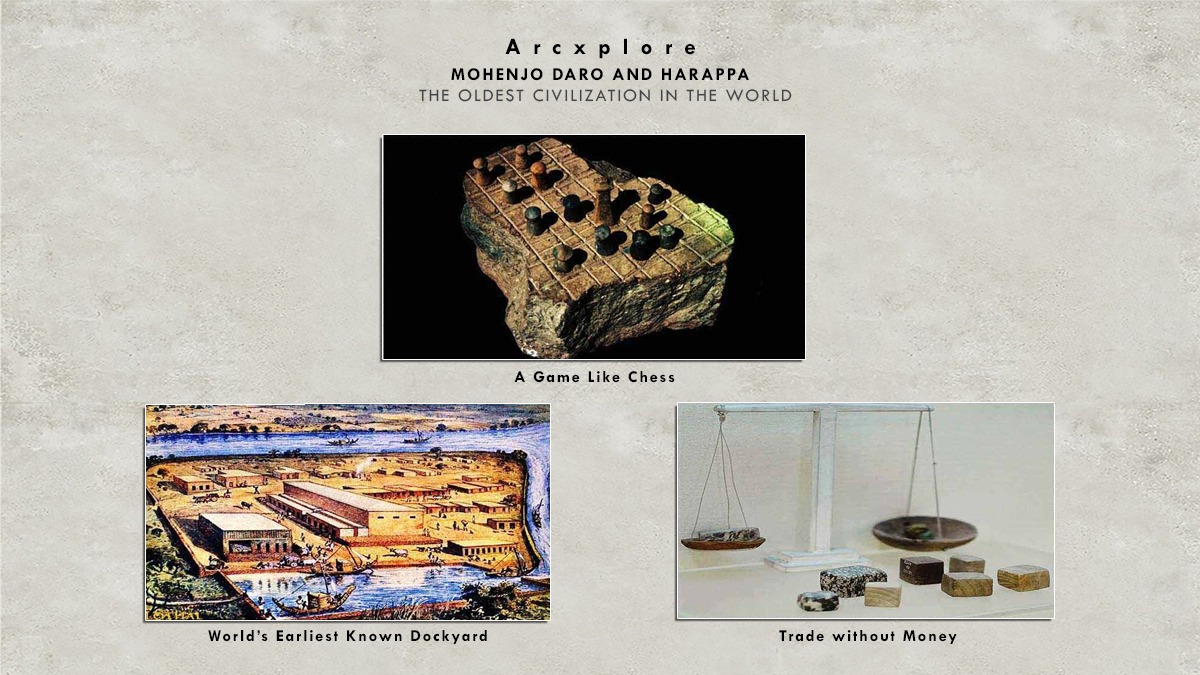
Which was the trade route between Harappan cities in Sindh and the Shah rostra Peninsula in those days the surrounding coach desert of today was a part of the Arabian Sea.
A Game like Chess
The Indus Valley Civilization appears to have liked games and toys, according to evidence. Archaeologists have discovered flat stones with engraved grid markings and playing pieces, indicating that the Indus people may have played an early form of chess. Dice cubes with six sides and spots have also been discovered, indicating that they may have invented the dice to play.
Mohenjo Daro’s Great Bath
The great baths of Mohenjo-Daro, a waterproof pool built on top of a mound of dirt are surrounded by walls of baked bricks. Cindy’s translation of Mohenjo Daro is “death’s heel” or “death’s mound.”

Harappans emphasized cleanliness, as seen by the bathing pool, which includes modest changing rooms. Each room has an adjoining bath area that surrounds the great bath.
Great Granaries of Harappa
Oldest World Civilization
Several granaries have been discovered. In the excavations of Harappa and Mohenjo-Daro, huge buildings with substantial brick foundations and sockets for wooden superstructures were discovered.
All of the granaries were built close to the riverbank so that grains could be conveniently delivered by boat. Several working platforms with circular bricks nearby were used for threshing grain in Harappa’s enormous granary.
Fire Alters of Kalibangan
Other than providing evidence of the oldest ploughed agricultural area ever exposed by excavation, Kalibangan, which means black Bengals, sits along the left bank of the dried-up bed of the river gagger in Rajasthan. There are multiple fire altars at Khali baingan, indicating that the Harappans believed in the ceremonial worship of fire.

Intriguing Figurines
The presence of some dance form, as well as skill craftsmanship, may be seen in terra cotta steatite and metal figures of girls and dancing stances. The bronze dancing girl, the steatite bearded priests King, and the terracotta will cart are among the most remarkable and well-known statues discovered during Indus valley excavations.
The Seal of Pashupati Mahadev
Thousands of carved seals and ambulances made of steatite agate have been discovered at Harappan sites. Copper and terracotta from Chirk A famous seal depict a venerated deity of the Indus culture Pashupati Mahadev. Who is thought to be the predecessor to the Vedic god Shiva, reclining in a stance evocative of the lotus position and surrounded by animals.
Worship of Mother Goddess
It’s largely assumed that the Harappans, in addition to other fertility and Vedic symbols, worshipped a mother goddess. Mother goddess worship or the fertility cult was widespread and popular in the Civilization, as evidenced by the discovery of a huge number of mother goddess figurines at practically every excavated site.
Strange Burials
The evidence of the disposal of the dead at Harappa is unique and interesting excavations have yielded fifty-seven burials of different types. In whose victims were buried in brick-lined rectangular or oval pits dug into the earth, accompanied with burial items like jewelry, seals, and ceramics in repair, a man was discovered buried with a Dog
Mysterious Massacre of Monhenjo Daro
Oldest World Civilization
Excavations at Mohen -jo- Daro’s streets uncovered 44 scattered skeletons sprawled on the streets as though doom had struck so abruptly that they couldn’t even get to their dwellings. All of the skeletons were flattened to the ground, including a father, mother, and child.
Who was discovered holding hands in the streets and in twisted postures among layers of rubble, ash, and debris? Archaeologists have determined that all of these persons perished as a result of violence. But what causes the violence remains a mystery, as one of the planet’s most fascinating ancient civilizations has also been proven to be one of the oldest ever unearthed. The looming issue is how many more are yet to be discovered. And it’s also worth wondering, as the archive does every day, how many of the existing known civilizations have been wrongly dated by academics.
